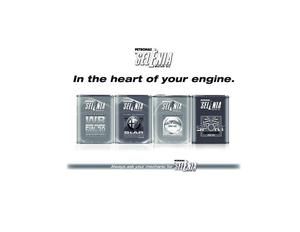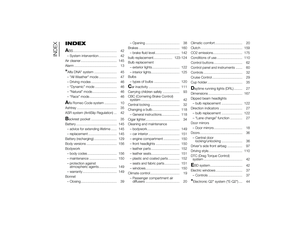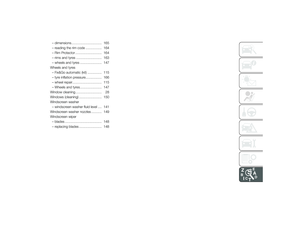Page 49 of 190

DRIVING MODES
Lever A is monostable type. In other
words, it always remains in a central
position.
The selected driving mode is indicated
by the corresponding LED switching
on in the panel and by an indication on
the display.
“Natural” MODE
ESC and ASR systems:intervention
thresholds aimed at providing comfort
and safety in normal grip and driving
conditions.
"Electronic Q2" system: the system
is calibrated to ensure the best driving
comfort.
Engine and gearbox/transmission:
standard response. “Dynamic” MODE
Activation
Move the lever A fig. 47 upwards (to the
letter “d”) and hold in this position for
half a second, until the corresponding
LED lights up and the "Dynamic" mode
activation indicator appears on the
display.
When "Dynamic" mode is activated, the
turbocharger pressure (bar) and engine
oil temperature (°C) screen is displayed
automatically fig. 49:
When released, lever A will return to the
central position.
ESC and ASR systems:
intervention
thresholds that ensure more enjoyable,
sportier driving whilst guaranteeing
the stability of the car. "Electronic Q2" system:
the system
is calibrated to increase traction whilst
accelerating on bends, improving
the agility of the car.
Engine and gearbox/transmission:
adoption of sports mapping.
IMPORTANT In "Dynamic", the
sensitivity of the accelerator pedal
increases considerably. Consequently,
driving is less fluid and comfortable.
Deactivation
To deactivate “Dynamic” mode and
return to “Natural”, move lever A fig. 47
downwards (to letter “a”) and keep it
in this position for half a second. In this
case, the LED corresponding to
“Natural” mode will light up and the
“Natural” mode activation indication will
appear on the display.
“Race” MODE48
A0L0109
49
A0L0110
46
GETTING TO KNOW YOUR CAR
24-9-2013 11:49 Pagina 46
Page 50 of 190

Activation
Move the lever A fig. 47 upwards (to the
letter “d”) and hold in this position for
5 seconds, until the "Race" mode
activation indicator appears on the
display. When "Race" mode is
activated, the longitudinal/lateral
accelerometer indicator screen
(G-meter information) is displayed
automatically. This considers
gravitational acceleration (G) fig. 50.
ESC and ASR systems:the systems
are deactivated in order to ensure
the fullest sensation of sport, leaving
the driver in full control of the vehicle.
When the vehicle is in unstable
conditions, the ESC reactivates
automatically when the brake pedal is
pressed until the ABS intervenes,
thus returning the vehicle to stable
conditions. "Electronic Q2" system:
the system
is calibrated to increase traction whilst
accelerating on bends, improving
the agility of the car.
Engine and gearbox/transmission:
adoption of sports mapping.
IMPORTANT In "Race", the sensitivity of
the accelerator pedal increases
considerably. Consequently, driving is
less fluid and comfortable.
IMPORTANT In "Race" mode the
transmission only works in MANUAL
mode. For further details, refer to the
"Using the transmission" section in
chapter "Starting and driving".
Deactivation
To deactivate "Race" mode and return
to "Dynamic", move lever A fig. 47
downwards (to letter “a”) and keep it in
this position for half a second. In this
case, the LED corresponding to
"Dynamic" mode will light up and the
"Dynamic" mode activation indication
will appear on the display. “All Weather” MODE
Activation
Move the lever A fig. 47 downwards (to
the letter “a”) and hold in this position
for half a second, until the
corresponding LED lights up and the
“All Weather” mode activation indicator
appears on the display.
ESC and ASR systems:
intervention
thresholds aimed at ensuring maximum
safety in low-grip driving conditions. It
is advisable to select "All Weather"
mode in the presence of low-grip road
surfaces.
"ELECTRONIC Q2" SYSTEM: the
system is deactivated.
Engine and gearbox/transmission:
standard response.50
A0L0111
51
A0L0112
47
24-9-2013 11:49 Pagina 47
Page 51 of 190

Deactivation
To deactivate “All Weather” mode and
return to “Natural”, move lever A fig. 47
upwards (to letter “d”) and keep it in
this position for half a second.
IMPORTANT
❒When the engine is next started, the
"All Weather" or "Dynamic" mode
selected previously is retained. The
system will reactivate in "All Weather"
or "Dynamic" mode, depending on
which mode was selected before the
engine was switched off.
❒ When the engine is next started, the
"Race" mode selected previously is
not retained. The system will
reactivate in "Dynamic" mode.
❒ It is not possible to go directly from
“Dynamic” mode to “All Weather”
mode and vice versa. You must
always first go back to “Natural”
mode and then select the other
mode.
System failure
In the event of system failure or a fault
with lever A fig. 47, no driving modes
can be selected. The display will become grey (same
screen as "Natural" mode) but without
an indication of the Alfa DNA setting.
The display will also show a warning
message.
EOBD SYSTEM
(European On
Board Diagnosis)Operation
The EOBD system (European On Board
Diagnosis) carries out a continuous
diagnosis of the components of the car
related to emissions.
It also alerts the driver, by switching on
the
warning light on the instrument
panel, together with a message on
the display, when these components
are no longer in peak condition (see
“Warning lights and messages”
paragraph in the "Knowing the
instrument panel" chapter).
The aim of the EOBD system (European
On Board Diagnosis) is to:
❒ monitor the efficiency of the system;
❒ indicate an increase in emissions;
❒ indicate the need to replace
deteriorated components.
48
GETTING TO KNOW YOUR CAR
24-9-2013 11:49 Pagina 48
Page 52 of 190

The car also has a connector, which
can interface with appropriate tools,
that makes it possible to read the error
codes stored in the electronic control
units together with a series of specific
parameters for engine operation and
diagnosis. This check can also be
carried out by the traffic control
authorities.
IMPORTANT After eliminating a fault, to
check the system completely, the
dedicated Alfa Romeo Dealership is
obliged to run tests and, if necessary,
road tests which may also require a
long journey.
RADIO SYSTEM(for versions/markets, where provided)
The radio system consists of:
❒supply cables for radio, speakers and
aerial;
❒ radio;
❒ aerial on front bumper;
❒ No. 2 tweeter speakers with 38 mm
diameter and No. 2 mid-woofer
speakers with 130 mm diameter,
fitted on the doors.
For further information on radio
functions and use, refer to the
dedicated Supplement attached to the
On-Board Documentation.
ACCESSORIES
PURCHASED BY THE
OWNERIf after purchasing the car, you decide
to install electrical accessories that
require a permanent electric supply
(radio, satellite anti-theft system, etc.) or
accessories that in any case burden
the electric supply, contact the
dedicated Alfa Romeo Dealership ,
whose qualified personnel, besides
suggesting the most suitable devices
from Lineaccessori Alfa Romeo, will
also check whether the car's electrical
system is able to withstand the load
required, or whether it needs to be
integrated with a more powerful battery.
44)
INSTALLING ELECTRICAL
/ ELECTRONIC DEVICES
Electrical and electronic devices
installed after buying the car in the
context of after-sales service must carry
the following label:fig. 5252
49
24-9-2013 11:49 Pagina 49
Page 53 of 190

Fiat Group Automobiles S.p.A.
authorises the installation of transceiver
devices on condition that such
installations are carried out in
a workmanlike fashion, following the
manufacturer’s instructions, at a
specialised centre.
IMPORTANT Traffic police may not
allow the car on the road if devices
have been installed which modify the
features of the car. This may also cause
invalidation of warranty in relation to
faults caused by the change either
directly or indirectly related to it.
Fiat Group Automobiles S.p.A. shall not
be liable for damage caused by the
installation of accessories either not
supplied or recommended by Fiat
Group Automobiles S.p.A. and/or not
installed in compliance with the
provided instructions.
RADIO TRANSMITTERS
AND MOBILE PHONES
Radio transmitter equipment (vehicle
mobile phones, CB radios, amateur
radio etc.) cannot be used inside the
car unless a separate aerial is mounted
on the roof.IMPORTANT The use of these devices
inside the passenger compartment
(without a separate aerial) may cause
the vehicle’s electronic systems to
malfunction. This could compromise
safety in addition to constituting a
potential hazard for passengers' health.
As far as the use of EC-approved
mobile phones is concerned (GSM,
GPRS, UMTS), follow the usage
instructions provided by the mobile
phone manufacturer.
WARNING
44) Take care when fitting additional
spoilers or non-standard alloy
wheels: they could reduce the
ventilation of the brakes and
affect efficiency in sharp,
repeated braking or on long
descents. Make sure that nothing
obstructs the pedal stroke (mats,
etc.).
PARKING SENSORS(for versions/markets, where provided)
They are located in the rear bumper
fig. 53 and their function is to detect the
presence of any obstacles near the
rear part of the car; they consequently
inform the driver, through an
intermittent acoustic signal.
ACTIVATION/
DEACTIVATION
The sensors are automatically activated
when reverse gear is engaged. As the
obstacle behind the car gets closer, the
acoustic signal becomes more
frequent.53
A0L0043
50
GETTING TO KNOW YOUR CAR
24-9-2013 11:49 Pagina 50
Page 54 of 190

ACOUSTIC SIGNAL
When reverse gear is engaged and
there is an obstacle behind the vehicle,
an acoustic signal is emitted which
varies according to the distance of the
bumper from the obstacle.
The frequency of the acoustic signal:
❒increases as the distance between
car and obstacle decreases,
culminating in a continuous acoustic
signal, when the distance is less
than approximately 30 cm;
❒ decreases if the distance from the
obstacle increases, until the signal
ceases entirely;
❒ remains constant if the distance
between car and obstacle remains
unchanged; if this situation concerns
the side sensors, the signal will
stop after approximately 3 seconds
to avoid, for example, indications
in the event of manoeuvres along a
wall.
If several obstacles are detected by the
sensors, only the nearest one is
considered. INDICATIONS ON
DISPLAY
(for versions/markets, where provided)
When the sensors are activated, the
screen in fig. 54 appears on the display.
Obstacle presence and distance
information is therefore provided both
by the acoustic signal and the
instrument panel display.
The system indicates a detected
obstacle by displaying an arc in one or
more positions according to the
distance of the obstacle and its position
in relation to the car.
If an obstacle is detected in the rear
central area, the display shows all the
arcs in the rear central area, up to
the one that corresponds to the
position of the obstacle itself.The signal is similar for obstacles in the
rear left or right area.
The arc that corresponds to the
position of the obstacle will flash.
The colour on the display depends on
the distance from and position of the
obstacle.
The car is close to the obstacle when
the display shows a single constant arc
and emits a continuous sound.
If there are several obstacles, the
closest one is indicated.
FAULT INDICATION
Parking sensor failures, if any, will be
indicated when reverse is engaged by
the switching on of the
warning
light on the instrument panel together
with the message on the display (see
“Warning lights and messages”
chapter).
GENERAL WARNINGS
45)4)
When parking, take the utmost care
over obstacles that may be above
or under the sensor.
54
A0L0044
51
24-9-2013 11:49 Pagina 51
Page 55 of 190

Under certain circumstances, objects
close to the vehicle are not detected by
the system and could therefore cause
damage to the car or be damaged
themselves.
Some conditions may influence the
performance of the parking sensors:
❒the presence of ice, snow, mud
or multiple layers of paint on the
sensor surface may cause reduced
sensitivity of the sensor itself and
therefore reduce the system
performance;
❒ mechanical interference (e.g. washing
the car, rain, strong wind, hail) may
cause the sensor to detect a
non-existent obstacle ("echo
interference");
❒ the presence of ultrasonic systems
(e.g. pneumatic brake systems of
trucks or pneumatic drills) near the
car could alter the signals sent by the
sensor;
❒ the variation in sensor position,
caused by variation in ride (due
to suspension component wear),
changing tyres, overloaded car,
or tuning that lowers the car, for
example, may affect parking sensor
system performance.
WARNING
45) The responsibility for parking
and other dangerous manoeuvres
always and in every case lies
with the driver. While carrying out
these manoeuvres, always make
sure that no people (especially
children) or animals are in the
area concerned. The parking
sensors are an aid for the driver,
but must never allow their
attention to lapse during
potentially dangerous
manoeuvres, even those executed
at low speeds.
IMPORTANT
4) The sensor must be free frommud, dirt, snow or ice in order for
the system to operate correctly.
Be careful not to scratch or
damage the sensors while
cleaning them. Avoid using dry,
rough or hard cloths. The sensors
must be washed using clean
water, with the addition of car
shampoo if necessary. When
using special washing equipment
such as high pressure jets or
steam cleaning, clean the sensors
very quickly keeping the jet more
than 10 cm away. Also, do not
apply stickers to the sensors.
52
GETTING TO KNOW YOUR CAR
24-9-2013 11:49 Pagina 52
Page 56 of 190

TPMS (Tyre
Pressure
Monitoring System)(for versions/markets, where provided)
The car can be equipped with a tyre
pressure monitoring system (TPMS),
which informs the driver of the tyre
inflation status via dedicated messages
on the display fig. 55.
The system comprises a radio-
frequency transmitter sensor fitted to
each wheel (on the rim inside the tyre),
which is able to send information on the
inflation pressure of each tyre to the
control unit.IMPORTANT
INFORMATION ABOUT
THE TPMS
46) 47) 48) 49) 50) 51) 52) 53) 54)
The fault indications are not stored and
will therefore not be displayed after
the engine has been switched off and
then on again.
If the fault conditions persist, the control
unit will send the relative indications to
the instrument panel only after the
car has been in motion for a short time.
TPMS FAILURE
In the event of TPMS failure, dashes will
be displayed instead of the tyre
pressure status together with the
activation of the dedicated
warning
light (see "Warning lights and
messages" section in the"Knowing the
instrument panel" chapter). To restore
correct operation of the system,
contact a dedicated Alfa Romeo
Dealership.
55
A0L0113
53
24-9-2013 11:49 Pagina 53
 1
1 2
2 3
3 4
4 5
5 6
6 7
7 8
8 9
9 10
10 11
11 12
12 13
13 14
14 15
15 16
16 17
17 18
18 19
19 20
20 21
21 22
22 23
23 24
24 25
25 26
26 27
27 28
28 29
29 30
30 31
31 32
32 33
33 34
34 35
35 36
36 37
37 38
38 39
39 40
40 41
41 42
42 43
43 44
44 45
45 46
46 47
47 48
48 49
49 50
50 51
51 52
52 53
53 54
54 55
55 56
56 57
57 58
58 59
59 60
60 61
61 62
62 63
63 64
64 65
65 66
66 67
67 68
68 69
69 70
70 71
71 72
72 73
73 74
74 75
75 76
76 77
77 78
78 79
79 80
80 81
81 82
82 83
83 84
84 85
85 86
86 87
87 88
88 89
89 90
90 91
91 92
92 93
93 94
94 95
95 96
96 97
97 98
98 99
99 100
100 101
101 102
102 103
103 104
104 105
105 106
106 107
107 108
108 109
109 110
110 111
111 112
112 113
113 114
114 115
115 116
116 117
117 118
118 119
119 120
120 121
121 122
122 123
123 124
124 125
125 126
126 127
127 128
128 129
129 130
130 131
131 132
132 133
133 134
134 135
135 136
136 137
137 138
138 139
139 140
140 141
141 142
142 143
143 144
144 145
145 146
146 147
147 148
148 149
149 150
150 151
151 152
152 153
153 154
154 155
155 156
156 157
157 158
158 159
159 160
160 161
161 162
162 163
163 164
164 165
165 166
166 167
167 168
168 169
169 170
170 171
171 172
172 173
173 174
174 175
175 176
176 177
177 178
178 179
179 180
180 181
181 182
182 183
183 184
184 185
185 186
186 187
187 188
188 189
189






